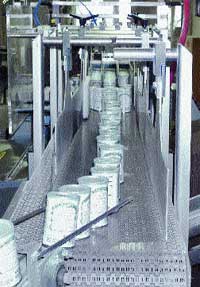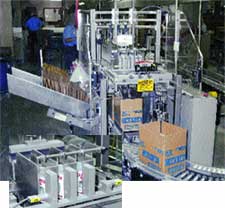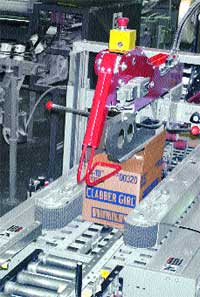Recipe calls for a dash of drop packing
January 29, 2014
Before supermarkets or The Pampered Chef, wholesale grocery stores provided baking ingredients for products baked from scratch. One of those grocery storefronts was Hulman & Co. in Terre Haute, IN. In 1879, Herman Hulman produced a baking powder formula called Clabber, and in 1923, after some refinements, it was called Clabber Girl Baking Powder. That product line is now the flagship product for the Clabber Girl Corporation.
On the fourth floor of Clabber Girl's warehouse in the downtown district of Terre Haute, sanitary-steel cans are fabricated for the Clabber Girl and Rumford product lines. The Clabber Girl double-seamed steel cans are conveyed to the packaging operations on the third floor. Constructed of steel rollers and guiderails, chute-designed conveyors feed cans through the floor to the filling area. After cans are filled, a lidding machine applies a metallized pull-tab, and overhead conveyors move cans 30 feet to a labeling machine.
The rotary filler for the Clabber Girl packaging line can produce up to 250 containers/min but was running at speeds of 210 containers/min before the drop packer installation. Clabber Girl felt Combi Packaging System's DP drop packer with an integrated case erector could help meet the filler's optimal speed. Ed Wilkins, plant manager for the Clabber Girl facility, says, "Before, the semi-automatic hand-packing system limited our output. The operator handled the cases and initiated the packing pattern on one line." The production line also includes a new 3M 120 AF case sealer that completes the case-packing process. The Glennon Group, a nationwide distributor and full-line integrator, installed and integrated the drop packer, conveyor and case sealer in June '01. The conveyor from the drop packer to the case sealer is supplied by Hytrol Conveyor.
Gathering the ingredients
After a can-end lid is applied, upright sanitary-steel cans travel on a 9-ft-high overhead conveyor running opposite the labeling and case-packing systems. Then, the conveyor makes a 90-degree turn, and cans slide down the conveyor/chute to a Mateer Burt horizontal roll-through labeling machine. The conveyor/chute sets cans in a horizontal position before they enter the labeling machine. With the pull-tab facing outwards, the machine places full-body paper labels on the cans. A hot-melt and cold-glue application adheres the labels to the cans. Then, a horizontal overcapping machine applies low-density polyethylene overcaps to the labeled cans. Next, the cans are orientated in an upright position by guiderails.
|
The filled and overcapped cans enter the drop-packing system and eventually bulk feed into a three-lane divider. |
The labeled cans move on a transition conveyor until they reach the drop packer's plastic-belt infeed. Guiderails from the transition conveyor direct the finished containers into a single-file formation on a three-container-wide plastic-belt infeed of the drop packer.
Drop-packing system
The labeled cans travel 2 feet and bulk feed into one of three lanes for case loading. Ultra High Molecular Weight (UHMW) polyethylene rails located on both sides of the belt-conveyor direct cans, which bunch up before entering the lanes, and place them into one of three lanes. A timer, powered by air cylinders, moves the UHMW rails back and forth. From there, cans travel in three lanes to the packaging head.
|
The case magazine feeds the forming station inside the drop packer, top. Inset, the packaging head is set and waits to drop product into cases below. |
The drop-packing machine operates under a programmable logic controller (PLC) from Allen-Bradley. The line also has Allen-Bradley photo sensors for container and case detection, case misforms, and jams at the case-sealing machine.
While labeled cans are moving forward on the drop packer's upper level, the integrated case erector works below. A side-loading case-magazine feeds flat, #125-test, single-wall corrugated cases from Smurfit-Stone into the forming station inside the machine. The machine folds the bottom flaps and indexes cases to the case lift, where they wait for the product to be dropped from above.
Eventually, the cans reach the packaging head on the top level with the appropriate case pattern set. On the day PD visited, the pneumatically driven drop packer was inserting 24 containers/case. The case was set to produce a double-stacking pattern, placing four rows on both the lower and upper levels.
With the appropriate number of cans at the front of the machine, the packaging head moves forward and deposits cans into cases. Underneath the packaging head is a case lift that moves the case up to meet the product. Attached to the bottom of the packaging head are spring-steel fingers that help guide the cans into the cases. With the installation of the drop packer, Clabber Girl is now running at 230 cans/min.
|
The top and side flaps are folded before adhesive tape is applied to the top of the case. |
After filling a case row, the packaging head shifts back, and another container pattern is dropped. The packaging head is an interchangeable part that can be replaced for other-size products. Wilkins informs PD that the drop-packing system's compact size fits nicely in the loft-style warehouse in Terre Haute.
After cases are filled, they roll onto a stainless-steel conveyor that makes a U-turn and travels towards the case sealer. Tape is applied across the top of the cases, which are then coded with a Julian and expiration date, and a product case count. A Zanasi Z-Jet 303 ink-jet coder applies the product information. The conveyor ends at that point, and cases are then hand-palletized.
The integration of the drop packer into "the recipe" for the Clabber Girl packaging line has been successful. Currently, Clabber Girl has two drop packers at the Terre Haute plant. Wilkins adds, "We have had such success with the drop packer that we are adding another. The next system will be for our twelve- and twenty-two ounce cornstarch product lines.
More information is available:
Drop packer, case erector: Combi Packaging Systems, 800/521-9072. Circle No. 279.
Case sealer: 3M Co., 800/722-5463. Circle No. 280.
Distributor, line integration: The Glennon Group, 800/582-8411. Circle No. 281.
Conveyors: Hytrol Conveyor Co., 870/935-3700. Circle No. 282.
Labeler: Mateer Burt, a div. of Barry-Wehmiller, 800/345-1308. Circle No. 283.
Overcapper: Donahower and Co., 913/829-2650. Circle No. 284.
PLC, photo sensors: Allen-Bradley, 414/382-2000. Circle No. 285.
Cases: Smurfit-Stone Co., 630/260-3500. Circle No. 286.
Ink-jet coders:Zanasi Co., 888/627-2633. Circle No. 287.
About the Author(s)
You May Also Like





